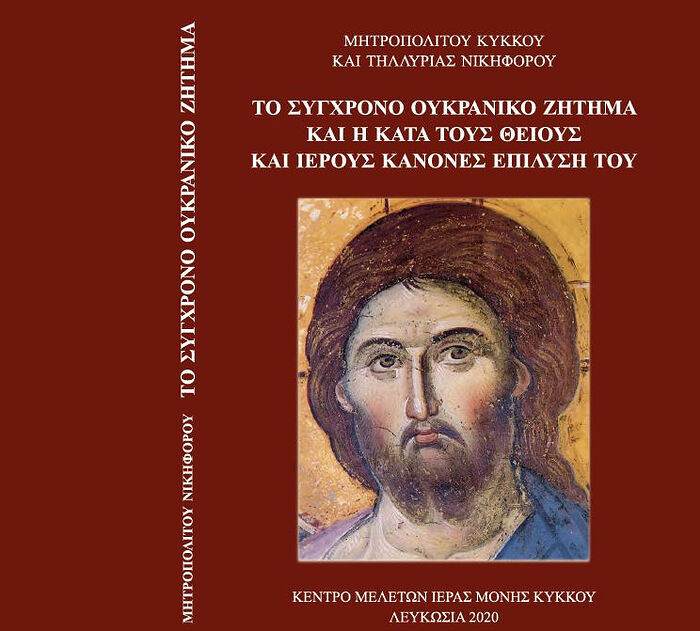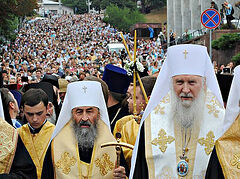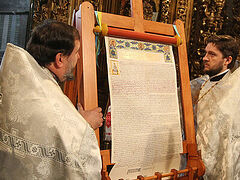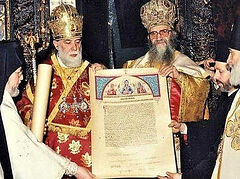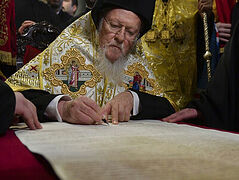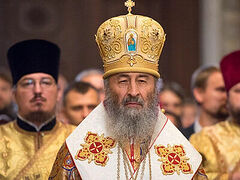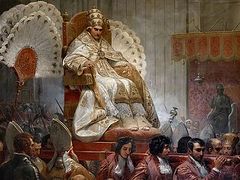His Eminence Metropolitan Nikiforos of Kykkos of the Orthodox Church of Cyprus recently published a book examining the burning Ukrainian issue from the point of view of the sacred canons of the Church.
Met. Nikiforos is one of the four Cypriot hierarchs that openly rejected Archbishop Chrysostomos’ unilateral decision to recognize the schismatic “Orthodox Church of Ukraine.” The witness of Met. Nikiforos and the other Cypriot hierarchs and his new book is especially important because it demonstrates that, despite the loud insistences of the Patriarchate of Constantinople, the Ukrainian scandal is not about Russians rejecting the special role of Constantinople and the Greek people within the Church, but rather, it is a question of fidelity to the Orthodox canons and theology.
Though several Greek primates have fallen in line behind Constantinople after being heavily pressured financially and politically, the heart of the matter is theological—that is, fidelity to Jesus Christ.
Met. Nikifors’ book, The Modern Ukrainian Question and its Solution According to the Divine and Sacred Canons, examines several questions:
-
Which Patriarchate’s ecclesiastical jurisdiction does Ukraine belong to?
-
Who has the right to grant autocephaly and under what conditions?
-
Does the Ecumenical Patriarchate have the canonical right to accept appeals from clerics outside its jurisdiction?
-
Who is the head of the One, Holy, Catholic, and Apostolic Church?
It is expected that the 233-page book will be translated from Greek into other languages of the Local Orthodox Churches.
In the meantime, the Department of External Church Relations of the Ukrainian Orthodox Church has published the main conclusions from the book, with the permission of Met. Nikiforos.
Below are Met. Nikiforos’ ten conclusions:
“Summing up all the presented ecclesiastical, theological, canonical, and historical materials on the Ukrainian question, we can draw the following conclusions:
-
The revocation of the Patriarchal gramota of 1686 and the appropriation by the Ecumenical Patriarch of Constantinople of jurisdictional rights to the ecclesiastical territory of Ukraine is a unilateral, self-declared, anti-canonical, and therefore, invalid action. The ecclesiastical consciousness of the Ecumenical Patriarchate and the Russian Church, and also the universal pan-Orthodox consciousness (that is, of all the Local autocephalous Orthodox Churches) has always accepted without doubt or hesitation the fact that the Orthodox Church in Ukraine has been under the ecclesiastical jurisdiction of the Orthodox Moscow Patriarchate for the past 332 years (1686-2018) and was its canonical territory. This pan-Orthodox Church consciousness was constantly manifested, without objections or warnings, through pan-Orthodox concelebrations and events, during irenic visits, as well as at international conferences and many other events.”
***
It is worth recalling that in terms of the Crete Council in 2016, which Patriarch Bartholomew believes to be of a binding, pan-Orthodox character, the Ukrainian Orthodox Church was unanimously acknowledged to be within the jurisdiction of the Moscow Patriarchate, as openly declared by Pat. Bartholomew himself at the Synaxis of the Primates in Geneva in January 2016. If Ukraine were truly within the jurisdiction of the Patriarchate of Constantinople, Crete would have been the time to step up and truly take responsibility for Ukraine. However, Pat. Bartholomew made no claim then to be representing Ukraine, and so he acknowledged on the pan-Orthodox level that Ukraine is within the jurisdiction of the Moscow Patriarchate.
His Beatitude Metropolitan Rastislav of the Czech Lands and Slovakia reminded Pat. Bartholomew about this in a letter from October 2018:
The Orthodox world recognizes the only canonical primate of the Ukrainian Orthodox Church—His Beatitude Metropolitan Onuphry of Kiev and All Ukraine. This fact was repeatedly mentioned and confirmed by the primate of the Great Church of Christ His Holiness Ecumenical Patriarch Bartholomew on behalf of all present at the Synaxis of the Primates of the Local Orthodox Churches that was held in Chambésy (Switzerland) from January 21 to 27, 2016. Therefore, any attempt to legalize the Ukrainian schismatics by the state authorities should be strongly condemned by all the primates of the Local Orthodox Churches.
Thus, following the Patriarch’s logic, he either does not truly believe Crete to be binding, or he believes himself, as Ecumenical Patriarch, to be above even the Councils.
***
-
Granting pseudo-autocephaly to schismatic groups in Ukraine without prior notification to and the consent of all autocephalous Orthodox Churches, as well as the Mother Church, which in this case is the Russian Church, is an action that completely contradicts the age-old canonical tradition and age-old Church practice and cannot be justified from a canonical point of view.
-
The removal of the excommunication from the excommunicated and anathematized without their sincere and deep repentance, as well as the anti-canonical assertion that the Ecumenical Patriarch once had and continues to have the right to accept appeals from clerics not only of his Church and his jurisdiction, but also of all Orthodox Patriarchates and autocephalous Churches—all this completely contradicts the canons, which were grossly violated. Therefore, granting the status of autocephaly to Ukraine cannot have valid canonical force, and should not be accepted by the Local autocephalous Orthodox Churches.
-
The anti-canonical granting of pseudo-autocephaly to the schismatic structures of Ukraine in no way led the Ukrainian people to canonicity, as the Ecumenical Patriarch claims, since the vast majority of the Orthodox Ukrainian people remain faithful to the canonical Church under the omophorion of Metropolitan Onuphry of Kiev and all Ukraine. On the contrary, Ecumenical Patriarch Bartholomew’s actions led to painful consequences—a catastrophic division of the Ukrainian Church and a great division of its Christian fullness with a disastrous consequence, leading to a terrible schism that threatens the body of world Orthodoxy.
-
The Ecumenical Patriarch’s unilateral, self-imposed and anti-canonical decision to grant an autocephalous church structure to the Ukrainian schismatic groups also creates a major Church problem and threatens pan-Orthodox unity with a terrible schism, as well as irrevocably undermining the pan-Orthodox authority of the Ecumenical Patriarchate as a coordinating center for the Orthodox Patriarchates and autocephalous Churches.
-
The termination of Eucharistic communion between two Churches, when it comes to dogmatic reasons or violations of the canons, is not only permitted, but also required by the canons themselves, as well as by age-old Church Tradition. Accordingly, the Orthodox Moscow Patriarchate acted correctly, guided by the canons (Apostolic Canons 10 and 11, Canon 5 of the First Ecumenical Council, Canon 2 of the Council of Antioch) when it decided to interrupt Eucharistic communion with the Ecumenical Patriarchate in hopes that the reasons that led to the break in communion would be canceled, and the ties between the two Churches would be restored again in “peace and love,” with the subsequent restoration of Eucharistic communion between them.
-
In this process of the development of the Ukrainian question, another anti-canonical opinion emerged, according to which the Archbishop of Constantinople and Ecumenical Patriarch is not “first among equals,” but “first without equals” in world Orthodoxy. This replaces the “ministry of primacy” with a “ministry of authority,” which violates the principle of conciliarity that has existed in the Orthodox Church for centuries.
-
In this very dangerous and unjustified crisis that was caused in the bosom of the Orthodox Church by the Ukrainian issue, a new dogma has also emerged, according to which the Ecumenical Patriarchate of Constantinople is the head of the Orthodox Catholic Church. Close collaborators of the Ecumenical See, distorting the meaning of the 34th Canon of the Holy Apostles, are trying to prove that the Ecumenical Patriarch should be considered the first and head of all primates. In other words, all other patriarchs, primates, and all bishops should recognize the Ecumenical Patriarch of Constantinople as the head of the Ecumenical Orthodox Church. However, this newfound theory has no historical, canonical, dogmatic, or ecclesiological grounds, because the Orthodox Catholic Church has no other Head than our Lord Jesus Christ. The only Eternal and Immortal Head of the Church is its Founder, Savior, and Redeemer, Christ.
***
The development of this teaching was examined in Pavel Darovsky’s three-part series, “The ‘Tomosology’ of the Patriarchate of Constantinople.” See Part 1 here. As a culmination, the tomos of autocephaly granted to the “Orthodox Church of Ukraine” no longer speaks of Christ, but rather the Ecumenical Patriarch himself, as the Head of the Church.
***
-
There can be no doubt and no objection that the principle of conciliarity, which is the main principle of governance in the Orthodox Church, was violated in Ukraine in favor of the arbitrary and despotic power of one person—Ecumenical Patriarch Bartholomew, who, ironically, only four years ago convened, headed, and coordinated the work of the Holy and Great Council in Crete (June 18-25, 2016), who declared in his address that “the Orthodox Church expresses its unity and conciliarity through councils. Conciliarity inspires the organization and the way in which decisions are made and determines the path that the Church follows.”
-
In conclusion, we also emphasize that “the Greek-speaking Churches, based on historical truth and canonical Tradition, and in order to avoid a final schism, must support the historical and canonical rights of the Russian Church, and they must not explicitly or through silence support the anti-canonical invasion of Constantinople into someone else’s jurisdiction. If they do otherwise, supporting the Greek Patriarch because of love for the nation and patriotism, they fall into the heresy of ethnophyletism, which was condemned by Constantinople itself in 1872” (quote from the article of Fr. Theodore Zisis, “Ukrainian Autocephaly: The Concealment and Misinterpretation of Documents”).

